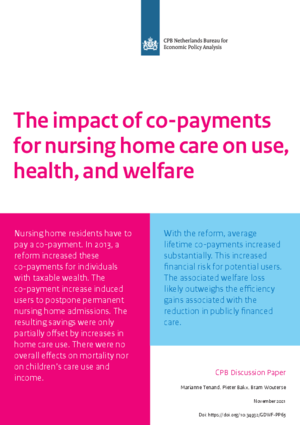The impact of co-payments for nursing home care on use, health, and welfare

In 2013, a reform (the vermogensinkomensbijtelling) increased co-payments for long-term care for people with financial wealth. A shown in a new empirical study, it induced older people to postpone nursing home use, but only by a few days on average. The reform reduced the financial pressure on the long-term care system, but at the cost of raising the financial risk of older adults.
With population aging, many countries seek to keep long-term care accessible while containing public spending. Co-payments play a role in balancing these goals by shifting parts of the costs to users and providing an incentive to only use necessary care. However, evidence on how co-payments affect care use, health and financial risk is limited.
A 100-euro increase in the monthly price of nursing home care lowers the time spent in a nursing home by 0.8 day. The offsetting increase in home care use is small and there is no overall effect on mortality. Because some people end up staying many years in a nursing home, the limited increase in the monthly co-payment induced a substantial rise in lifetime co-payments. A cap on lifetime co-payments would limit the associated financial risk while preserving the incentive to postpone an admission.
More info: EsCHER Working Paper
